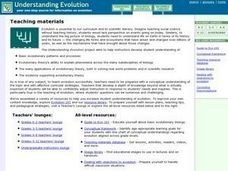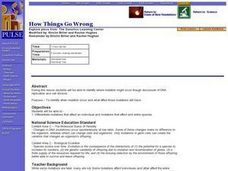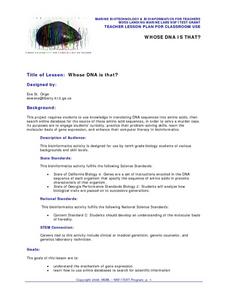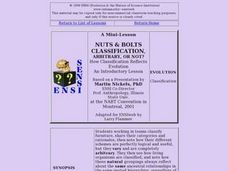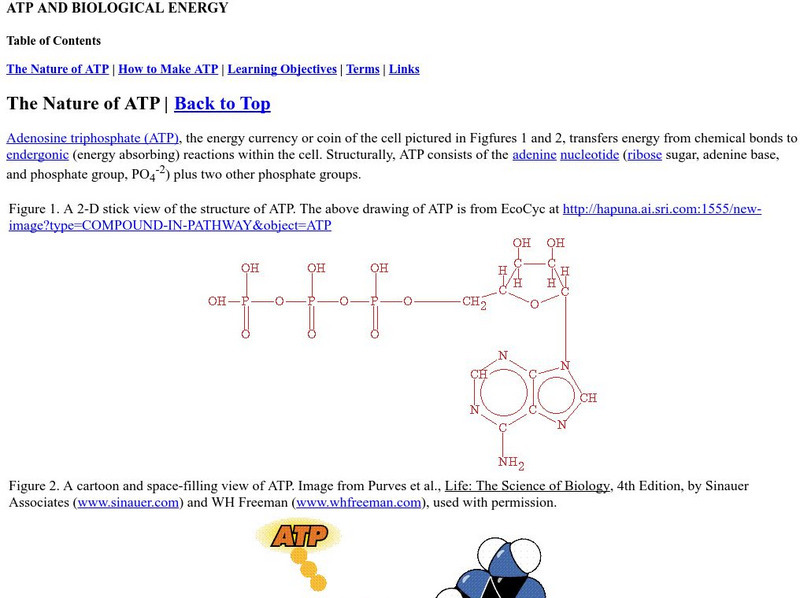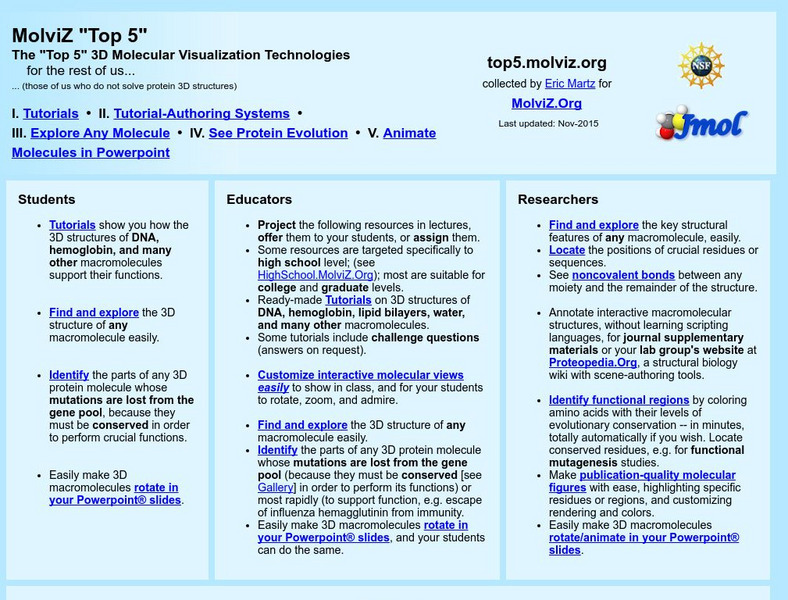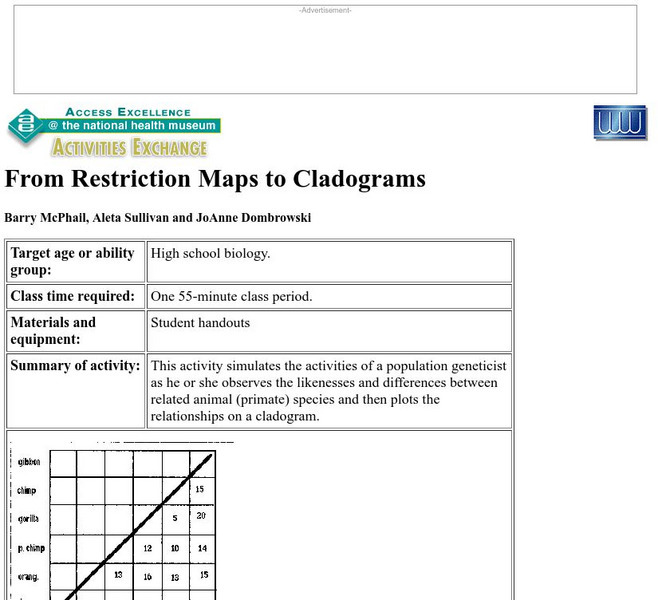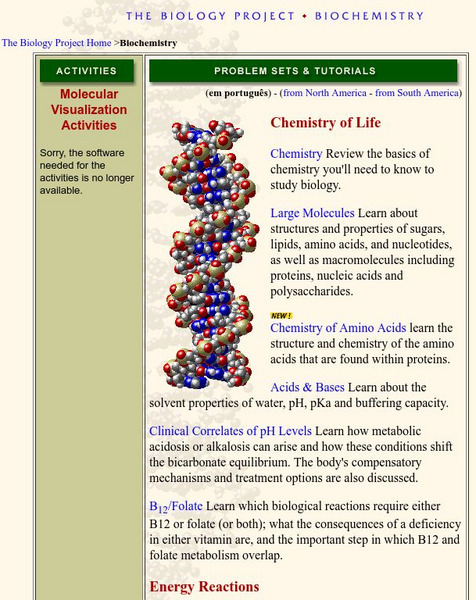Curated OER
Making Cladograms
Learners construct cladograms (evolutionary trees), showing how shared derived characters can be used to reveal degrees of relationship. They interpret and analyze cladograms, and determine where unclassified vertebrates would fit on a...
Curated OER
Zoology Word Search Puzzle
In this science worksheet, middle schoolers look for the words that are related to the concept of zoology that is reviewed in the sheet. They also acquire new vocabulary.
Alabama Learning Exchange
Botany Scavenger Hunt Where's the Ginkgo?
Learners use a science journal to log plants that are native to Alabama. In this plant lesson plan, students identify characteristics, describe environments, and classify the plants that they find.
Curated OER
Genetic Engineering
Students examine the advantages and disadvantages of genetic engineering. In this genetics lesson students simulate the genetic engineering of a human insulin gene.
Curated OER
How Things Go Wrong
Students identify where mutations might occur and examine what effect those mutations will have through class discussion of DNA replication and cell division. Students then differentiate between mutations that affect individuals and...
Curated OER
Mountaintop Removal Coal Mining
Students become familiar with coal as an energy source and how it is mined. In this coal lesson, students research the effects of coal mining on the environment. Students discuss the various problems associated with coal mining....
Curated OER
X or Y- Does it Make a Difference?
Students examine the X and Y chromosomes. In this research lesson plan, students use the 5E lesson plan model as they read articles about human chromosomes then discuss their findings and opinions.
Curated OER
Whose DNA Is That?
Pupils investigate the use of technology in order to identify different sequences of amino acids by using online web tools. They enhance problem solving skills with amino acid identification skills and strengthening comfort with using...
Curated OER
Nuts & Bolts: is Classification, Arbitrary, Or Not?
Middle schoolers, in groups, classify furniture, share their categories and rationales, then note how their different schemes vary, perfectly logical and useful, but completely arbitrary.
Curated OER
Wolf Pack in a Bottle
Students participate in an activity of a mock electrophoresis using paper chromatography to study DNA and genetic restriction mapping.
Curated OER
Human Evolution
Young scholars make and use observations of Laetoli footprints to provide clues to life in the past. They collect and analyze data to study the relationship between foot length and body height.
Curated OER
From Genomes of Species
Pupils investigate genomic research being done and its potential for understanding, treating, and possibly curing human genetic conditions. The potential of proteomic research as a companion to the work being done with genomics is...
National Institutes of Health
Ncbi: The Molecular Biology of the Cell: The Chemical Components of a Cell
Advanced chapter of the book "The Molecular Biology of the Cell" describes and provides illustrations of our most current understanding of the chemical makeup of cells and their components. Explains in detail how electron activity keeps...
National Health Museum
Access Excellence: Molecular Biology/primate Phylogeny
This lesson plan involves comparison of amino acids to create a phylogenetic tree of primates. Students will also use other species information to draw conclusions about evolutionary relationships.
Soft Schools
Soft Schools: Biochemistry and Organic Chemistry Quiz
Take an interactive quiz over biochemistry and organic chemistry. After completing the quiz, check your score, and then revisit any incorrect question for further review.
Cosmo Learning
Cosmo Learning: Introductory Biology
A collection of video lectures from an introduction to biology course taught at Massachusetts Institute of Technology. The course covers fundamental topics like biochemistry, genetics, molecular biology, and cell biology with thirty-four...
National Health Museum
Access Excellence: Making a Phylogenetic Tree Lesson Plan
Constructing phylogenetic trees may be a daunting task for students, but this lesson plan is a simulation of what molecular biologists must do to determine relationships. This plan is for students who have a good grasp of DNA structure...
Estrella Mountain Community College
Online Biology Book: Chemistry Ii: Water and Organic Molecules
Online biology textbook discussing the chemical nature of water, and the importance of its molecular structure to life. Also discusses at length the organic molecules nucleic acids, proteins, lipids, and carbohydrates.
Estrella Mountain Community College
Online Biology Book: Atp and Biological Energy
Through full-color images and concise information, learn about adenosine triphosphate, or ATP, the molecular unit of energy currency of cells.
National Health Museum
Nhm: Amino Acid Sequences Show Evolution
This lesson plan focuses on differences in the amino acid sequence of hemoglobin and myoglobin proteins. They use the number of differences to create a phylogenetic tree.
Howard Hughes Medical Institute
Hhmi: Biointeractive: Virtual Transgenic Fly Lab
A fantastic interactive laboratory in which transgenic flies are created and used to study circadian rhythms. Excellent supporting information and resources for teachers and students.
University of Massachusetts
University of Massachusetts: Rasmol & Chime
This site from the University of Massachusetts links to downloadable freeware (Rasmol and CHIME) which are required to view 3-D images common on organic chemistry tutorials.
National Health Museum
Nhm: Restriction Maps to Cladograms Lesson
This lesson plan requires students to analyze DNA restriction maps to determine the differences in the sequence for several primates and humans. They then use the information to create a cladogram.
University of Arizona
University of Arizona: Biochemistry
Problem sets, tutorials, and activities related to biochemistry.


